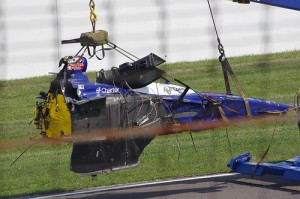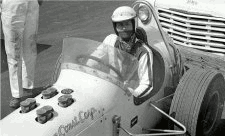Should IndyCar Have a Fuel Rule?
ByIn the wake of Mike Conway's scary crash on the final lap of the Indy 500, Arie Luyendyk is questioning whether the IndyCar Series should require competitors to meet a minimum fuel level through the end of the race. Luyendyk, himself a two-time winner of the 500, believes it's too dangerous for drivers to implement fuel-saving strategies on ovals.

The remains of Mike Conway's car after getting into the fence at Indianapolis. (Mr. 0 photo, flickr.com / CC 2.0)
Conway's car got airborne after clipping the left side of Ryan Hunter-Reay, who suddenly slowed after running out of fuel in turn three on the final lap of the race.
Would this be a good rule to have on the books, or is this just a knee-jerk reaction to an ugly crash?
Imagine for a moment that there was a rule requiring finishers to have at least 1.5 gallons of fuel in the tank after finishing the race, which is apparently similar to what Formula One requires. What if a driver just won the Indy 500 and in post-race inspection the officials were only able to siphon out 1.45 gallons of fuel? What would they say? "Sorry boys... we have to take that trophy away!" Or perhaps the team would just be fined -- which amounts to no deterrence at all. In practice I believe it would be a very unpopular rule.
While I hate that the crash happened and that Conway was injured, we have to admit that it's just something that happens in this sport. Ordinarily the circumstances involved are not a problem: if drivers are too slow they are black-flagged or at least relegated to running on the track apron. Indy is a bit more complicated since the speeds are so fast and there is essentially only one racing lane. Making matters worse, they removed the track apron in 1993 (preferring warmup lanes), taking away a large portion of track that could be used by drivers to avoid an incident or to pull down and out of the way if a problem occurred with the car. Maybe a better question to ask is whether or not Indy cars really need to go a zillion mph in the first place. Does it really put on a better show?
Let's be thankful we got through another oval race without a large portion of a car flying up into the grandstands and keep it at that.
And that reminds me...
What was with all the black-flagging for "blocking" during the Indy 500? Didn't it get a bit excessive? I saw instances where a car was down low and a driver attempted a pass where it was nowhere near humanly possible and still the leading car got a black flag for what amounted to moving over a couple of inches. What happened to finding a way to set the guy ahead of you up for a pass? Or maybe trying to pass on the outside of a straightaway?
If I were a new fan watching that race I would have concluded that if a driver wanted to pass on the inside, it was the lead driver's obligation to move over and let him pass. And we're to believe that the future of Indy car racing is in better hands now that Tony George is gone?

